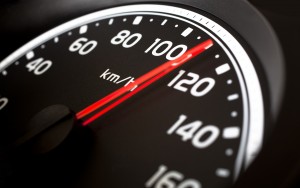The search for distance has taken up many pages in many golf magazines and publications over the course of time. It’s the Holy Grail of golf for so many players – the secret that may exist that will unlock long drives that fly farther than ever before. Many of my students talk about how they want to gain distance, but very few of them understand what it takes to move the needle and gain club head speed. When it comes to making changes, gaining club head speed can be one of the hardest metrics in a swing to adjust. But it can be done with some quality practice and patience.
The main thing to understand when it comes to club head speed is your braking point. No, that’s not a misprint. The body will only allow you to swing at a speed that it can comfortably bring to a halt at some point; in other words, the body is always trying to make sure you don’t get injured. So just trying to swing faster may gain you a tiny bit, but if your body hasn’t trained for the load that a faster moving club creates, you are never going to be able to sustain it and there is a good chance you can get injured.
Training for speed in the golf swing happens in a few places. First, it happens away from the golf course or driving range and in the gym. I know what you are thinking: here we go with another person telling me I need to work out. You’re right! Having a golf specific training program can have great benefits to your quality of life, but can really benefit your ability to gain speed. Over the last 6 months, I have trained for golf using a program created by a Titleist Performance Institute certified professional, and it has made a big difference. Two years ago my comfortable driver club speed was 94 miles per hour, with a high (and I felt like I was coming out of my shoes) of 98 miles per hour. Now, my on course comfort speed is 98 miles per hour and I can get up to as high as 103. That may not seem like a huge difference, but it is huge for me! But in order to get to these club speed changes I had to strengthen my core, glutes, hamstrings, and hip flexors, using exercises that put my body in uncomfortable positions at first. So don’t underestimate the value of getting physically ready to swing faster. If you do, that swing may not last and your body may pay for it with an injury.
As you look at those gains in club head speed, it’s pretty apparent that moving the club speed needle isn’t easy. So once you start training off the course, you also need to train on the range for your speed. One of my favorite drills is to have a person hit balls with their driver on TrackMan radar, which gives me all of their club and ball data, including club speed. Then I hand them an old shaft with no club head on it and ask them to swing it as fast as they can 3 times. After that, I hand them their driver back and tell them to hit a ball. Almost every time, the club head speed jumps up 2-3 miles per hour. Why? Because you should learn to swing faster by swinging faster! Swinging a light weight object is critical to teaching your body how to speed up and move faster. Many of my students believe that swinging a weighted club is good for speed, but they are wrong. That builds golf muscles, which isn’t a bad thing; unfortunately, it only teaches you to swing slower and that isn’t the name of the game. So get an old shaft or an alignment rod, grab it with your right hand (for right handed players) and “swish” it through the hitting area as fast as you can 3 times, then pick up your driver and enjoy your new found speed! But remember, you must train like this a lot to keep the speed you found and be able to translate it on the golf course.
None of this training will mean anything if you don’t have the technique needed to swing faster. As I have mentioned before, sequencing the golf swing is critically important to get all of the parts to fire at maximum velocity. So understanding that the order of the golf swing should be the hips, torso, arms, then the club is very important. Any change in this sequence can severely limit your ability to generate the most power possible for your body. Work on the correct sequencing by using a classic step drill; put your feet together, swing the club back, and just as it is reaching the top of the swing but still moving away in the backswing, step through slightly toward the target with your lead foot and swing through. This is a great drill and essentially uses the same sequence as throwing a ball or stepping into a tennis forehand to teach you the most powerful transfer of energy.
In the end, my keys for club speed and distance are pretty simple. Train your body to swing faster using 3 areas: no club (off course), a light weight object (no club head), and then with a club (sequencing). If you can consistently practice and train for speed you will eventually get results and see distance gains on the golf course. So go find out what your current speed is so that you have a benchmark, and then get out there and work on blowing that number out of the water and find new parts of the golf course down the fairway that you didn’t know existed.




